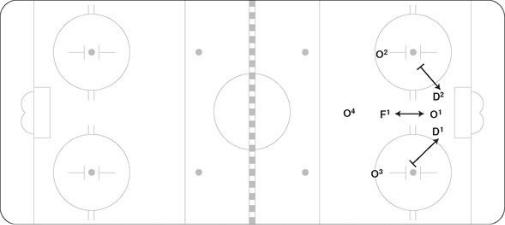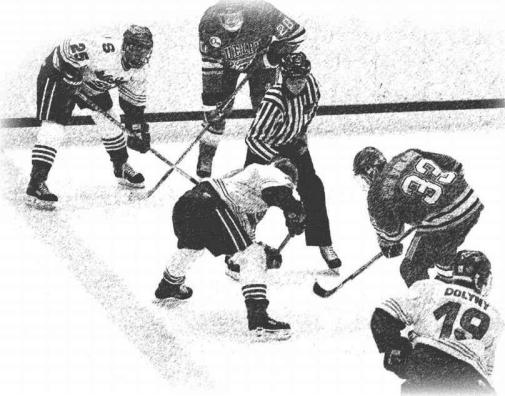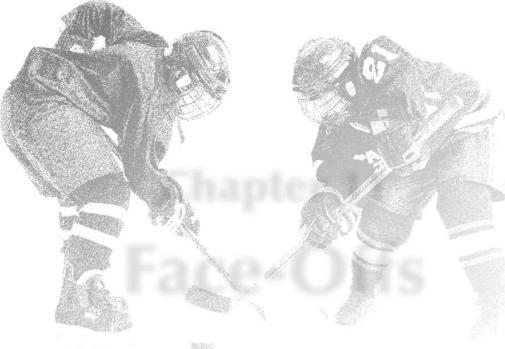
- •Foreword
- •Preface
- •Key to Diagrams
- •Reading Pressure and Options
- •Reacting to Support the Breakout
- •Breakout Plays
- •Control Breakouts
- •Counters
- •Regroups
- •Dump-In Entries
- •Mid-Ice Entries
- •Wide-Lane Drives
- •The Funnel
- •Two-on-One Attacks
- •Two-on-Two Attacks
- •Three-on-Two Attacks
- •Offsides
- •Activating Defense Into Offensive Zone Entries
- •Cycling
- •Playing Behind the Net
- •Stretching the Zone: Low-High Plays
- •Activating Defense in the Offensive Zone
- •Attack Zone Plays
- •Power-Play Breakouts
- •Gaining and Maintaining Possession off the Entry
- •Zone Setup
- •Five-on-Three Power Play
- •Four-on-Three Power Play
- •Forechecking Systems
- •Neutral Zone Forechecking
- •Neutral Zone Forechecking Systems
- •Neutral Zone Backchecking
- •Neutral Zone Backchecking Systems
- •Handling Defensive Zone Entries
- •Defensive Zone Systems
- •Situational Guidelines for Defensive Zone Coverag
- •Face-Offs and Penalty Kills
- •Forechecking and Penalty Kills
- •Pressuring the Entry
- •Defensive Zone Play
- •Three-on-Five Penalty Kill
- •Three-on-Four Penalty Kill
- •Offensive Zone Face-Offs
- •Neutral Zone Face-Offs
- •Defensive Zone Face-Offs
- •Power-Play Face-Offs
- •Penalty-Kill Face-Offs
- •Special Face-Off Situations
- •Managing Staff
- •Dealing With Officials
- •Adjusting Your Playing Strategy
- •Managing Lines
- •Line Changes
- •Handling the Moment
- •Index
- •About the Authors
Three-on-Four Penalty Kill
The three-on-four penalty kill adds its own complexity and is similar to yet different from killing the three on five. The difference is that the defending three must decide if they are going to take away the top two shooters or stay near the front of the net. Usually the 4on3 is much easier to kill than the five on three. The PK unit focuses on playing around the man at the net leaving them three on three against the shooters.
■ TRIANGLE, ONE HIGH
Most teams on a four-on-three power play will set up in a diamond with one player at the net, so the triangle penalty kill with one high is the most effective system to use. F1 stays in the middle of the ice (figure 10.26). When the puck is up top, he stays head to head with the one opposing D. When the puck is passed, F1 stays in the middle and uses his stick to deny the pass from O2 to O3. D1 and D2 are ready to move out and take the shooting lane away from O2 and O3. D1 and D2 do not tie up with O1 at the net but are ready to defend his stick and get body position if the puck is shot through.
Figure 10.26

Remember the old adage that “defense wins championships.” Working on your teams PK structure, getting all players on the same page and having your goaltender be your best penalty killer are all ways to give your team a better chance to win.

Part III
Special Game Situations

Chapter 11
Face-Offs
The offensive face-off coahing staffs and players time to implement set plays, making it the only time that hockey players get to play football. Teams should prepare for face-offs in a number of ways. First, practice them by going through the plays on a walk-through basis. Once a month, take time in practice to run through what you want the players to do at each face-off dot. It does take time, and it tends to slow the pace of practice, but there
are roughly 60 face-offs in a game, which means 60 times to win or lose possession of the puck—so it is worth the time. In addition to all players going through the face-offs, the centers must work on the skill of taking the draw. It doesn’t take long for a coach to quickly do 50 reps with a center before or after practice, focusing on his technique. Centers should work on winning draws on the forehand, on the backhand, by tying up, and at times by touching the puck through to catch the opposition by surprise.
Consider having a face-off play book that includes responsibilities as well as diagrams illustrating the execution patterns. Some teams have developed a DVD to give to the centers, who much like a quarterback in football need to know the formation and how to set up. This DVD should have dialogue and a clear illustration of the plays. Because of the clarity and camera angle, it may be best to collect plays from NHL, college, and junior games and then edit the material down for the players.
Finally, depending on the age of your group, you may want to have the centers pick the option for their line for that night or come to you with a play they think will work. This type of player ownership can be effective; the players will definitely focus if it is their play because they want it to work.
Have face-off plays for all face-off dots and for specific game situations. The way a team lines up five on five is much different from four-on-four and three-on-three situations. Don’t forget power-play five on four, four on three, and five on three; penaltykill four on five, three on four, and three on five; and late-game pulled goaltender plays defensively and offensively. Over the course of my NHL career across three different teams and seven different head coaches, we implemented many face-off set plays, but they tended to be drawn from the following categories.
